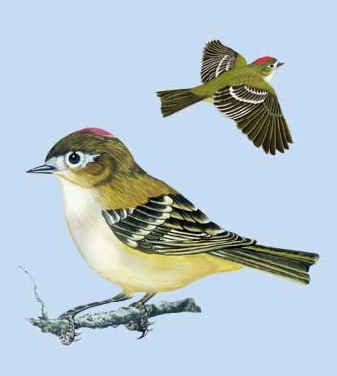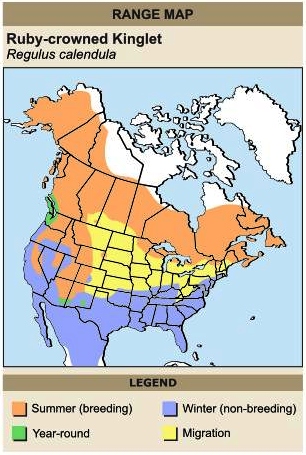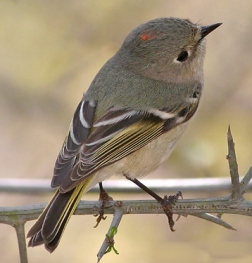|

Medium
kinglet, olive-green upperparts and gray-washed, pale yellow underparts.
Head has inconspicuous tuft of red crown feathers, white spectacles.
Wings are dark with two white bars. Tail is slightly notched and has
white edges. Weak fluttering flight on shallow wing beats.

|
RUBY-CROWNED
KINGLET
Regulus calendula
PASSERIFORMES
Kinglets (Regulidae)
Range and Habitat
Breeds from Alaska east across Canada to Newfoundland,
south to southern California and New Mexico in the west,
and to the Great Lakes region and northern New England in the east.
Spends winters south from southern British Columbia and California across
the southern tier of states to
southern New England. Preferred habitats include
coniferous and deciduous forests.
SOUND: "tsee-tsee", "liberty-liberty-liberty", "je-dtit",
"cack-cack"
The Ruby-crowned Kinglet was described in 1766 by Linnaeus; its generic
name is Latin for 'little king'. It differs sufficiently in its voice
and plumage from other kinglets that it is occasionally afforded its
own genus, Corthylio.
They feed lower in the canopy than the Golden-crowned and characteristically
hovers above a twig looking for caterpillars, aphids, and other insects.
A group of kinglets has many collective nouns, including a "castle",
"court", "princedom", and "dynasty" of
kinglets.
The Ruby-crowned Kinglet is a small songbird found throughout North
America. Typical breeding habitats of this bird include coniferous woodlands
in Canada, Alaska, northern New England and the western United States.

Nests are cup-shaped and suspended from branches on the conifers. In
winter months, this species migrates southward to the southern United
States and Mexico. Some western populations are permanent residents.
Recently, less disturbed populations have been discovered farther north.
This species forages for food in trees and shrublands, eating insects,
spiders, berries and tree sap. The conservation rating for the Ruby-crowned
Kinglet is Least Concern.
|